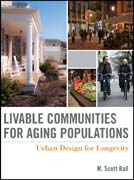
Livable communities for aging populations: urban design for longevity
Ball, Scott M.
Written by an architect with Duany Plater-Zyberk with expertise in design foran aging society, this is a guide to urban planning and urban design solutions to accommodate the needs of a population aging in place in both existing andnew communities of various scales. Complete with case studies of successful communities, the book shows how, through (social, economic, transportation, andpublic health) policy, land use, and urban design decisions, a community can allow for residents to age in place gracefully. INDICE: FOREWORD, Andr s Duany xiINTRODUCTION, Robert Jenkens xiiiPREFACE xivACKNOWLEDGMENTS xviiiPART I CHALLENGES AND OPPORTUNITIES 11 THE LONGEVITY CHALLENGE TO URBANISM 3The Challenge 3The Scale of Response: Pedestrian Sheds and Neighborhoods 7Seniors Housing Communities as Change Agents 11Toward the Development of Lifelong Neighborhoods 14Conclusions 182 ACCESS AND URBANISM 21Introduction 21Go Forth Boldly 22On Whose Behalf We Regulate 24Advancing Accessibility Aspirations Beyond Minimum Standards 31Stewardship 383 HEALTH, HEALTHCARE, AND URBANISM 45Environmental Health, Safety, and Welfare 45Reestablishing a Healthy Land-Use Paradigm 48Knowledge and Action: Finding an Institutional Basis for Public Health and Land-Use Planning Integration 50Beyond Intent and Toxicity: Establishing Frameworks for Planning Action 54Beyond Planning: Healthy Environment Implementation Frameworks 644 NEIGHBORHOOD WELLNESS AND RECREATION 71Urban Design and Wellness Industry Market Research 71Aging and Wellness 73Redefining the Lifelong Environment: Wellness in Community 77Conclusion 86PART II NETWORKS AND DIVERSITY 875 CONNECTIONS 89Connectivity 91Pedestrian Accessand Transit 1036 DIVERSITY 109Planning for Diversity 109Zoning for Diversity 111Building Codes and Housing Diversity 121PART III SENIORS HOUSING 1257 EVOLUTION OF SENIOR DEVELOPMENT TYPES 129Early Senior Care Models 129Institutional Neglect 133Diversification of the Senior Housing Type 1348 THE LIFELONG NEIGHBORHOOD MARKET 149Market Study Elements of Critical Importance to Lifelong Neighborhoods 149Factors That Contribute to Residency in Age-Restricted Communities 156Factors That Deter Older Adults from Moving to Age-Restricted Communities164Lifelong Neighborhoods and Influencing Factors 1679 SENIORS HOUSING COMPONENTS 171Initiating Lifelong Neighborhood Design with a Market Study 172SeniorsHousing Components 174Service Policy Components 198Built-Environment Policy Components 199PART IV URBAN TO RURAL CASE STUDIES 20710 PENN SOUTH NORC CASE STUDY OF AGING A DENSE URBAN CORE 209Lifelong Summary 209Context 210Innovations in Health and Wellness Programming: Penn South Discovers the NORC Concept 212Connectivity and Access 214Dwellings and Retail 216Health and Wellness 218Community Building Spaces 219Jeff Dullea Intergenerational Garden 22011 BEACON HILLCASE STUDY OF AGING AND TOWN CENTERS 223Lifelong Summary 223Context 224Innovations in Health and Wellness Programming 225Connectivity and Access 226Dwellings and Retail 227Health and Wellness 230Community Building Spaces 23212 MABLETON CASE STUDY OF AGING AND NEIGHBORHOOD CENTER 235Lifelong Summary 235Overview237Context 238Redeveloping as a Lifelong Community 239Mableton Elementary School Redeveloped as a Civic Center 25313 ELDER-CENTRIC VILLAGES: EXPLORING HOW SENIOR HOUSING CAN INCENTIVIZE URBAN RENEWAL IN RURAL AMERICA 257Lifelong Summary 257Evaluating Small-Town Living and Walkability 259Providing an Elder-Centric Village 263INDEX 267
- ISBN: 978-0-470-64192-7
- Editorial: John Wiley & Sons
- Encuadernacion: Cartoné
- Páginas: 288
- Fecha Publicación: 16/05/2012
- Nº Volúmenes: 1
- Idioma: Inglés
